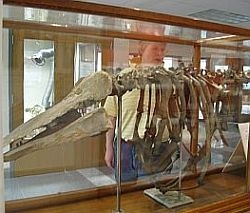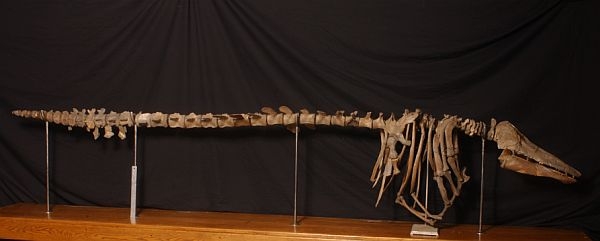 (Mitch Wertlieb) For centuries, Lake Champlain has been a place of discovery, and one that’s convinced many visitors to stay. We’ll look deeply into the lake on Mondays this month in our series "Stories from the Lake," examining the lake and its role in shaping the history and culture of the region.
(Mitch Wertlieb) For centuries, Lake Champlain has been a place of discovery, and one that’s convinced many visitors to stay. We’ll look deeply into the lake on Mondays this month in our series "Stories from the Lake," examining the lake and its role in shaping the history and culture of the region.
I’m Mitch Wertlieb.
Samuel de Champlain will get most of the attention during this summer’s Quadricentennial celebrations, but we can’t begin to understand his historic exploration of the lake that bears his name without a realization that thousands of years before his arrival the lake was a very different place.
The most famous visitor we know of from that time before Champlain, was a whale we now call Charlotte:
(Mehrtens) "Well yes, it goes by the name the Charlotte whale after the name of the locality in which it was found, and it’s actually the state fossil of Vermont.")
(Wertlieb) Charlotte Mehrtens introduces us to the skeletal remains of a beluga whale unearthed in Vermont in the mid-19th century. Mehrtens is a professor and Chair of the Geology Department at the University of Vermont.

This whale will never be confused with Moby Dick–it measures just about 10 feet long and only two and a half feet top to bottom, but it does share many characteristics with some modern whales like this beluga, and provides critical clues into what Vermont looked like around 12,000 years ago:
(Mehrtens) "Whales are marine mammals and the important thing about finding a whale in sediments in Vermont is that it tells us that at one time, marine water or ocean water was in this part of Vermont."
(Wertlieb) But that ocean water wasn’t here first.
Mehrtens says records of animal fossils taken from mud at the bottom of the lake tell us that Vermont went from a lake to an ocean called the Champlain Sea….and back to lake again.
And we have mammoth chunks of ice to thank for getting us back to the lake we know today.
(Wertlieb) Mike Winslow is a staff scientist with the non-profit Lake Champlain Committee:
(Winslow) "The lake was pretty much carved out by glaciers… that’s the main force that acted upon the system…over 10,000 years ago. But as they came through the weight of the ice pulling along underneath it rocks and gravel began scraping it away like sandpaper at the softer dolomites and limestones of this basin and carved out a trench that then got filled with water as the glaciers left."
(Wertlieb) All this activity took thousands of years to complete before signs of the earliest human activity. Historian Fred Wiseman:
(Wiseman) "The earliest really good evidence that we have are the remains of what’s called fluted points left over by the native people that were here, probably around 10,200 to maybe almost 11,000 years ago. These have been found on the islands of Lake Champlain, they’ve been found on old beach ridges. They’ve been found surrounding points that have been found right in this area here. These were used probably for hunting upland game as well as perhaps sea mammals."
(Wertlieb) By the time Champlain arrived in 1609, the lake would have appeared much as it does to us today. Champlain had already founded colonies around Quebec. To protect them he allied the French with various Indian tribes. And Champlain ultimately decided to side with the northern tribes. Historian Will Randall says the Algonquins convinced Champlain to journey south with them to a body of water they called "the Lake Between."
(Randall) "They arrived by canoe. The river they had come down, the Richaleau, was just too rough for their wooden boat. So two to three men in the canoe, Champlain, two French lieutenants and sixty Algonquin Indians, Champlain was wearing his armor, and was ready with his Arquibus, his oversized musket, and the lake to him was so peaceful, by contrast, full of hope he thought, possibilities for the future. He loved i. He said it was the most beautiful sight he had ever seen, and he put his name on it."
(Wertlieb) But the decision to align with those tribes led to conflicts with others. Champlain and his outnumbered Indians confronted the Iroquois at present day Fort Ticonderoga. The morning of the battle, Champlain fired a musket capable of releasing 9 slugs with one shot… and killed three Indian chiefs. It marked a victory for Champlain, but says Randall, it came at a heavy cost.
(Randall) "So it was a technical victory for Champlain and the Algonquians, but it was a disaster because it set off 150 years of warfare between Indians on both sides of the lake, with the French and Algonquians constantly at war with the English and the Iroquois. And it only ended with the fall of the entire French and Indian empire, in the 1760’s."
(Wertlieb) Randall says it also meant Champlain could no longer explore the region in safety, and it marked the end of his presence on the lake that bears his name.
(Randall) "He got out of Vermont as fast as he could, because by the time he got back to the Vermont shore after Ticonderoga he was being pursued by a large number of Iroquois."
(Wertlieb) But Champlain’s influence and allegiances set into motion events that would determine the destinies of nations-from his native France, to rival Great Britain, and a fledgling collection of rebel colonies. Since Champlain’s arrival, nothing would ever be quite the same.
I’m Mitch Wertlieb.
Note: Next Monday, we’ll consider the unsettled period that followed Champlain’s visit. And join us this afternoon during All Things Considered, as VPR’s Neal Charnoff picks up the story with the persona of Champlain…and the people he met in the region.
Our music was from the Spencer Lewis CD "Vermont Serenades."
Our historical consultant has been Willard Sterne Randall, historian, author and professor at Champlain College.